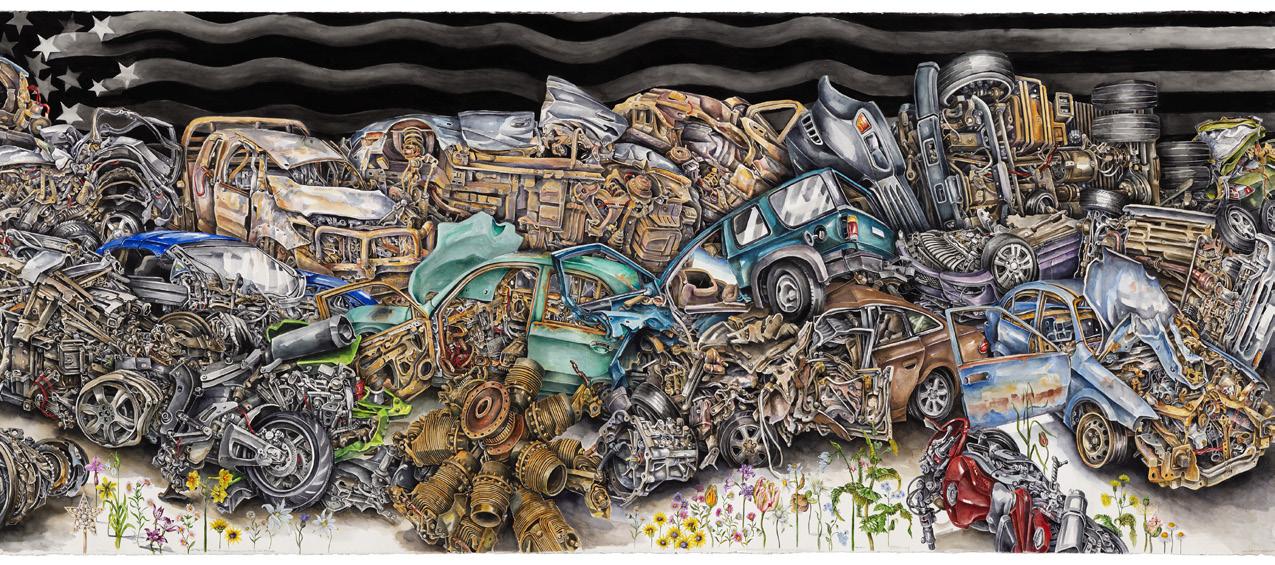
4 minute read
eX de Medici: The Wreckers
By Dr Jenny McFarlane

eX de Medici, The Wreckers, 2019 (detail), watercolour on paper, 114 x 594 cm
Earlier this year, the National Gallery of Australia announced the major acquisition of eX de Medici’s masterpiece, The Wreckers.
A painstakingly-constructed watercolour tableau spanning almost six metres, The Wreckers escalates the artist’s interrogations of the global political, economic and environmental crisis and the devastating ramifications of power and greed.
It is a sprawling scene of violence and destruction, created in de Medici’s unique aesthetic, drawing on her background as a tattooist. The heavily-coded work shows a mass of wrecked cars against a black star-spangled banner, adorned by flowers and interspersed with the names of “the worst people responsible for doing the worst things in the world”.
Begun in late 2018 and shown at Sullivan+Strumpf, Sydney in November last year, this work foreshadows a much larger metaphorical car crash: the unfolding of the climate catastrophe and the collapse of the West as we know it.
The paradox of beauty and ruin raises questions about the growing opacity of government and indifference of the masses, who are distracted by a tidal wave of entertainment.

eX de Medici portrait by Gary Grealy
My little dog sits on my lap as I write this. She exists in the moment of my being still long enough for her to feel the sun on her back and doze. She has an enviable capacity for being, existing purely in the moment. The past and future are opaque to her. For a moment as I write, I notice her experience of time.
We are advised to learn this capacity and find this time where neither past nor future press. Adult colouring-in books, watering the garden, gazing at the blue sky, yoga mats, meditation, time out, these are all strategies to be turned to this purpose. To feel the passage of the clouds across the sun as the sensation of a shadow cooling the skin and then be present to the returning warmth. To hear the distant sound of a car stopping at the lights and the wind in the trees, to take time out of life, and make time stand still, and to simply experience moments stretch into hours. But where true meditation is a disciplined, purposeful practice, much of our current conversation about being in the moment is escapist; an act of denial in the face of recurrent trauma. As a society this escapism bleeds into a way of life. For when we choose to disappear into the moment, the corollary is a refusal to take issue with the bald-faced lies, blatant self-interest, and cowardly misuse of legal frameworks set up to protect the vulnerable. Are we taking the time to challenge theories once held in good faith, now made over into increasingly threadbare veils to greed and self-interest?
In choosing to be in the moment, in choosing to ignore the press of past and future, and not to act, have we rather slid into some sort of time-distorted crystal cave, frozen out of time, unable to act, but only watch?
There is good reason to seek time out. The everyday has become a traumatic experience where time crashes in on itself, one traumatic event after another, piling up every which way. There is no space to analyse and make sense of events. The sensation of time in this situation is quite different to being in the moment, rather we feel jettisoned from the ordered progression of time. In a car crash each millisecond is experienced frame by frame with heightened senses, each deferred blow and repercussion is separated by long intervals. The slow crunch of metal, the slip of break-pads, the halt in forward momentum, the slow slide of bags from the front seat to the floor are each experienced in sharp detail. And nothing can be done. We are extracted from time, unable to act. Frozen, we can neither prevent the inevitable crash nor recover sufficiently from each impact to meet the ricocheting consequences. This is not the periodic crash of waves striking a beach, no cosmic metronome is at work here. Rather we are caught up in a jangled traumatic pile-up of recurrent trauma. Trapped in this distempered, freakish frequency it would take near superhuman strength to step back, mark the disrupted patterns and trace their source. If this is a turning point in historic time, we find ourselves T-boned at the intersection. How can we expect to both notice the bald patch on the tire and link it to the unexpected weather event, truly engage with the short cut taken on our safety device, or anticipate the chain of events that sees an automatic guidance system wrest control from the human pilot? One or two manageable irregularities spiral rapidly into the unmanageable on a daily if not hourly basis. So, we find ourselves tossed from one event to another, distempered, disempowered and finally incapacitated by our failure to order events, slow our mind and retrieve the ability to intervene usefully and halt the pattern of crunching, folding metal, police tape and arterial flow.
Standing in front of this work is not the moment to speak of reassurance. This is a moment for realisation, to recognise the car crash and to take a moment, step out of the crystal cave and understand what it would take to extract ourselves from this awful pile-up.










